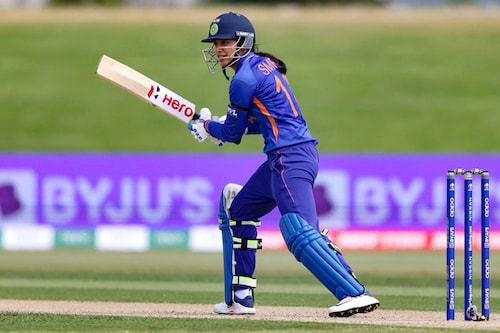Storyboard18 - 'Brands are not investing in women's cricket, they're investing i
As the 2022 ICC Women's Cricket World Cup kicks off, here's where the sport and players stand in marketers' game plans


On March 6, a clip of the Indian women"s cricket team playing with Bismah Maroof"s baby daughter Fatima went viral. Maroof is the captain of Pakistan"s women’s cricket team. This happened right after the women in blue defeated their arch-rival Pakistan by 107 runs in the maiden match of the ICC Women’s Cricket World Cup 2022 at Bay Oval in New Zealand.
Netizens appreciated the players putting aside their rivalry for a moment of camaraderie and cuteness.
Strange that brands didn’t jump on this moment for topical advertising. But many would also be relieved that this moment was left alone by brands.
The general communication themes that brands are following to cheer the players this time around are passion and resilience. For instance, Star Sports, the official broadcaster of ICC events and Indian Women’s home tours, for its latest campaign #HamaraBlueBandhan stitched together clips of everything from Smriti Mandhana and Mithali Raj smashing sixes to Jhulan Goswami chasing for big wickets.
Edtech firm Byju’s, the official global sponsor of the International Cricket Council (ICC) and official brand partner of international cricket tournaments including ICC Cricket World Cup, ICC Champions Trophy, and Women’s Cricket World Cup, released an anthem to cheer the cricketers.
The idea of a film like #HallaMachaDe is to drive passion to younger players who want to pursue cricket as a career, and of course, cheer the ladies in blue, says Vineet Singh, vice president - brand and creative strategy, Byju’s.
While ICC’s sponsors Bira91, Coca-Cola and Upstox, among others, will be supporting the Women’s Cricket World Cup, there aren’t many other major brands flocking to the game.
This is mainly because brands are sandwiched between the ongoing Men’s India vs Sri Lanka Test series and the upcoming IPL, which starts later this month.
Gaurav Bahirvani, chief executive officer, One One Six Network, says, “Indian brands have been shying away because they prefer to spend on tournaments locally where the eyeballs are the maximum. Post-Covid-19 a lot of brands have adapted the home spend strategy."
The other reason for brands to stay away from the Women’s Cricket World Cup is that the matches are happening in the early first half of the day in India because it’s hosted in New Zealand—when the traffic both on digital and television is the lowest.
According to industry estimates, there is a 40-45 percent drop in brand associations for the Women’s Cricket World Cup this time.
Usha International has been supporting and promoting sporting events like the IPL, ultimate flying disc, Kalari, Mallakhamb, siat khnam, cricket for the differently-abled, sports for visually challenged (athletics, kabaddi, judo, and powerlifting), as well as football. The brand has brought in cricket team captain Mithali Raj as its brand ambassador ahead of ICC Women"s World Cup. The company said it will run ad campaigns during World Cup matches as a part of its marketing promotions.
Komal Mehra, head of sports initiatives and associations, Usha International, says the brand wants to promote “an active and healthy lifestyle" through their multiple sports associations. As far as Raj is concerned, Mehra says, she is “actively challenging the status quo" and that fits with the brand’s philosophy.
Currently, Smriti Mandhana is the highest-paid woman cricketer. Mandhana earns up to Rs 1 crore for a brand deal per year. Raj is equally popular with brands and commands around the same as Mandhana. The other few top players earn anywhere between Rs 40-75 lakh per deal.
Although the rising income from brand deals for individual players is a positive trend, Bahirvani says, “Brands are not investing in women’s cricket, they are investing in selected women cricketers. Apart from a few from the national team, there is still a huge divide that we witness when it comes to brand engagements. Brands" spending is based on the popularity index of the cricketer—be it men or women. Of course, the divide is greater when it comes to women, but this attitude must change. The amount of effort put in by a woman cricketer is the same as that put in by their male counterparts. But the pressure to win is still stronger for the latter."
Google India’s latest ad film for its #SearchForChange campaign addresses the issue of lack of awareness about the achievements of Indian women cricketers, the push they need, and the spirit of the game.
Brands experts believe that women’s cricket tournaments haven’t been able to get viewership numbers that will attract brand investments. Truth be told, brand spending is still a function of eyeballs.
Ramakrishnan R, cofounder and director of Baseline Ventures, candidly tells Storyboard18 that it’s a constant challenge to pitch women’s cricket tournaments. Brands still prefer being associated with men’s cricket games. “We hear marketers in various forums speaking on investing in new sports, women cricketers, but largely these are only in words. There are only a few brands who are willing to walk the talk when it comes to investing in sports."
First Published: Mar 08, 2022, 18:02
Subscribe Now